 Remember blowing bubbles with that solution in the little bottles and the plastic wand? The craft of writing is a bit like blowing bubbles (life is like a box of chocolates!) This holds true not only for your dramatic approach, but also for the characters in your story as well.
Remember blowing bubbles with that solution in the little bottles and the plastic wand? The craft of writing is a bit like blowing bubbles (life is like a box of chocolates!) This holds true not only for your dramatic approach, but also for the characters in your story as well.
The study of real bubbles is actually a science which combines physics, geometry, and even calculus! And, as with most natural phenomena, the dynamics that drive them have a parallel in psychology as well. For example, the math that describes a Black Hole in space can equally be applied to describing a prejudice in the mind.
So, by observing bubbles we can more easily grasp some otherwise intangible concepts about the psychology of stories and of the characters in them.
Turning our attention to stories, let’s look at several dramatic endeavors that can benefit by applying the qualities of bubbles. Bubbles burst. Sometimes you want them too, other times you don’t. The larger a bubble gets, the more impressive it is, but the more fragile as well. Until a bubble bursts the tension along its surface (surface tension) increases. But once it has burst, all the tension is gone. So the key is to blow the bubble as large as you can without exceeding the maximum sustainable tension. To do this, you need to know when to stop blowing, seal it off, and let it float on it’s own. In addition, you need to consider how hard to blow, how fast to blow, and to master the art of pulling away the wand to allow that magic moment when a bubble with a hole in it seals itself to become a perfect sphere.
When introducing a dramatic element into your story for the first time, consider how much material to work with at a single dramatic unit. Too little material tries to blow a bubble with not enough solution. It may not even make a film across the wand, and if it does, it will snap at the first breath before a bubble can form. Too much, and it drips off the wand, slobbering all over everything else, and snapping apart as well, because the sheer weight of the stuff makes the membrane too thick to flex. So, don’t work with dramatic units too large or small. Don’t focus on details too tiny or grand movements too large. Find the range and scope of your dramatic concepts that your readers or audience can hold onto while you pump it full of promise and then let it float into their hearts and minds on its own.
How hard you blow is equally important. As you may recall, blowing too hard will simply spit the solution right out of the wand and onto your parents’ carpet. (Why you chose to blow bubbles in the house even after having been told not to is no more fathomable than why you chose to be a writer, even though you knew better!)
Blow too soft, and your solution will just wiggle and vibrate in the wand, never bowing out to become a bubble at all. Eventually the solution in the wand will simply evaporate, and you’ll have spent a lot of time blowing with no bubble to show for it. Now a master storyteller can use this effect to his or her advantage. Get the right amount of solution on the wand and then just vibrate the blazes out of it with a gentle blow, tantalizing your audience, who is going to wonder if anything will every come of it. Just when it looks like the solution has almost evaporated too much to work, you pick up the airflow and form the bubble right before their eyes. Or, you might just keep it vibrating, a red herring, and simply let it dissolve out of the wand. Better be sure of your skills, though, because you want your audience to know you blew it, not to think you blew it.
And do you recall how if you blow at one intensity you get a single bubble, and if you blow with a different push you get a string of small bubbles? In fact, you can even get a series of medium bubbles if you find that narrow mid-range.
Dramatically, you can drop a lot of little bits of information, a few mid-sized bits of information, or one big bit, all with a single blow. (Killed 7 with one blow!). These are the Multi-Appreciation-Moments (M.A.M.) in which a single dramatic movement, passage, or discourse propels more than one dramatic element into the story.
Bubbles have size. The size of a bubble, in writing as in soap (or in writing “soaps”), depends primarily on the size of your wand and the huff in your blow.
Short stories are one size wand. Mini-series are another. Haiku are still one more. Each one has a maximum size of bubble it can produce, no matter how hard you blow. But size isn’t everything. There is such a thing as the beauty of perfection. Your idea is your solution, your format is your wand; try to make sure not to blow too hard for the wand/solution ratio you are using.
Surface Tension – wonderful phrase, that! Someone should use that for a title. More wonderful still is the way it works. Stories are about structure and passion. Your solution is about water and soap. Too much water and nothing happens. Too much soap and it all glops up. When you get the right mix of structure and passion, you’ve got the right raw material for a great bubble.
What holds the surface of the bubble together is the attraction among the soap and water molecules. What keeps it from collapsing is a slightly higher pressure on the inside than on the outside. A larger bubble has more tension because there is more surface. And yet, the total surface area of a collection of smaller bubbles far exceeds that of a single bubble occupying the same space. In addition, smaller bubbles are more stable, lasting far longer.
Use big bubbles for big events of singular identity with a limited life span. Use smaller bubbles collectively as a consistent foundation of longer duration.
Put your ear to the soap foam on dishwater or a hot bath, and though the mass remains largely constant, you can hear the satisfying snap, crackle, and pop of individual bubbles as they burst. Such formations can add stability to your story, even while providing an underlying level of surface tension, punctuated by hundreds of tiny eruptions. In addition, you can shape foam into all kinds of complex forms, while the shape of individual bubbles is far more limited.
While bubbles, on their own, are usually round, if you dip a bent piece of wire (such as a clothes hanger) in solution, you can create triangles, squares, and even approximations of hyper-cubes!
Although one might argue that the film from one wire side to the next does not comprise a bubble, and the enclosed area of such a shape does not either, guided by these outside influences a shaped bubble may indeed occur within the space bounded by the wires that doesn’t directly touch the wires. One shape, for example, may create a square bubble within another bubble. So, although the larger bubble is directly connected to the wires, the inner bubble is only connected to the planar surfaces of the outer bubble.
Ah, but I wax scientific. Fact is, the “set pieces” of your story are the wires dipped into your dramatic solution. An obvious heavy-handed control technique, you can also create very specific shapes by building those second-generation bubbles within bubbles, which are not formed by direct influence of your set pieces, but rather by indirect influence from being attached to those dramatics that ARE connected to the set pieces.
It’s a great point, but not for the faint of heart.
Bubbles combine. When two bubbles encounter each other, they might just bounce off like billiard balls. But if conditions are right, they join, creating a common interface between them. They are spherical except where they are joined, which becomes a flat side. More than two bubbles can combine, and when they do, all sorts of additional, symmetrical interfaces are created.
You entire story should be like a collection of bubbles, interfaced together. Each single bubble is another dramatic element or point. Over the course of your story you have blown them one by one until your story has fully taken shape. Then, on their one, one by one they begin to pop. Some of the solution is spattered away, some is absorbed by the remaining bubbles. Due to the extra solution, the remaining bubbles pop faster and faster until all the original bubbles have burst.
Let’s close by seeing how bubble science can help describe what your characters do you in your story. Suppose Sally calls on the phone complaining to Jane about a personal issue she is facing. Jane knows just what to say, but simply saying it will be rejected and not have the comforting effect she wants. In fact, Jane is smart enough to realize that she has to start out slow and easy, and over the course of the conversation blow a bubble of comfort big enough to enclose the problem.
So, with patience, Jane continues to talk to Sally, starting by enclosing a small part of the issue, then slowly expanding her support until it hold the whole thing inside. Now if Jane is too full of herself, has the habit of “beating a dead horse,” is emotionally needy herself and has to have confirmation from Sally that her problem is completely solved, or is just inexperienced, then she won’t know when to stop blowing and will continue pumping support into the conversation until the bubble gets so large it bursts.
But, if she knows what she’s doing, Jane will recognize when the bubble is big enough and then pull away the wand and stop blowing so that the sphere can form. She can do this by changing the subject, not off-topic, but to something tangential, to something touched upon in the conversation, but instead of talking about the part of that new topic that was connected to the personal problem, she now talks about other aspects of that topic that don’t involve Sally’s original issue.
Moving sideways in topic at the right time is like pulling the wand sideways from the bubble so that it can close.
Of course, Sally might be mired in her problem and stuck to the wand. But Anne may be in the room with Jane, hear that Sally is trying to come back to the original issue, and (being a good friend and student of psychology) realize another lateral move is needed. Anne would then raise her hand to get Jane’s attention (who would ask Sally to hold for a moment). Anne offers another off-topic comment based on what she has heard of the conversation. Jane passes the comment on to Sally on Anne’s behalf, and now Sally has been doubly distracted. At this point, either the bubble is free of the wand, or Sally simply won’t let go.
If the bubble is free, then it’s effect will remain within Sally long after the conversation and will work to resolve her angst. If it is not free, the air will just whoosh right back out of the wand and the bubble will deflate as if it never was, and Sally can go on moping about her problem.
Now, you might think this is all very complex, but it is this kind of bubble interaction that makes characters seem fluid rather than built of bricks. But do real people act like that? Sure they do. In fact, the very dramatic scenario I just described happened to me two days ago. That’s how I got the idea for this writing tip.
I was “Jane,” and with “Anne’s” perceptive interjection, I was able to assuage Sally’s angst, free the bubble, and Sally has been quite happy for the last 48 hours.
Real life psychology, character psychology, story psychology… the answer is blowin’ in the wind.
Bring the threads of your story together
with StoryWeaver Story Development Software
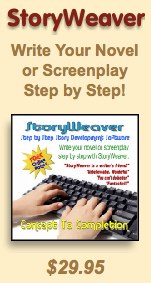 StoryWeaver will take you step-by-step from concept to fully developed story. More than 200 interactive Story Cards (TM) guide you through each step and automatically reference your work on previous steps. So, your story is constantly evolving as you revise, refine, and fold each version into the next.
StoryWeaver will take you step-by-step from concept to fully developed story. More than 200 interactive Story Cards (TM) guide you through each step and automatically reference your work on previous steps. So, your story is constantly evolving as you revise, refine, and fold each version into the next.
With our 90 day money-back guarantee you can try StoryWeaver risk-free.
And, even if you choose not to keep it, you still get to keep our Writer’s Survival Kit Bonus Package!


 Who are you, really? Do you even know? Or do you just think you know?
Who are you, really? Do you even know? Or do you just think you know?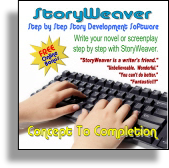
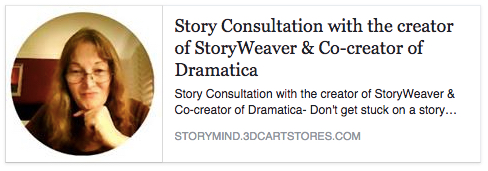
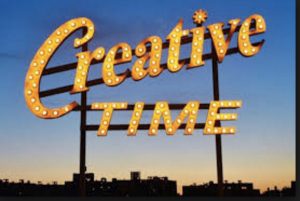 You sit in your favorite writing chair, by the window, on the porch, or in the study. You wear your favorite tweed jacket with the leather elbow patches, or your blue jeans, or your “creative shoes.” You look around at the carefully crafted environment you spent months arranging to trigger your inspiration. Reaching eagerly forward you place your hands on the keyboard or grasp the pen or pencil, and… Nothing happens.
You sit in your favorite writing chair, by the window, on the porch, or in the study. You wear your favorite tweed jacket with the leather elbow patches, or your blue jeans, or your “creative shoes.” You look around at the carefully crafted environment you spent months arranging to trigger your inspiration. Reaching eagerly forward you place your hands on the keyboard or grasp the pen or pencil, and… Nothing happens.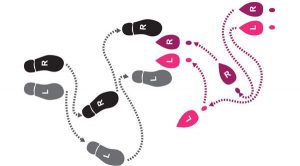 It is easier to come up with many ideas than it is to come up with one idea.
It is easier to come up with many ideas than it is to come up with one idea.
 Unlike screenplays, there are no budget constraints in a book. You can write, “The entire solar system exploded, planet at a time,” as easily as you can write, “a leaf fell from the tree.”
Unlike screenplays, there are no budget constraints in a book. You can write, “The entire solar system exploded, planet at a time,” as easily as you can write, “a leaf fell from the tree.”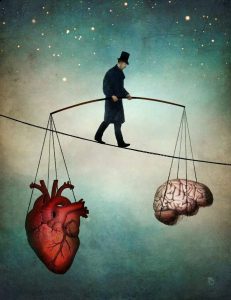 Realize that your mind is a narrative-generating machine. That is why narratives exist in the first place: because they mirror the processes of the mind. But the mind is also a repository of topical information – subject matter – and engages in the process of synthesizing two or more old ideas into a new one. The new ideas may or may not fit into the narrative the mind is constructing. And yet the heart is drawn more to the new ideas, just as the mind is drawn more to a balanced and complete structure.
Realize that your mind is a narrative-generating machine. That is why narratives exist in the first place: because they mirror the processes of the mind. But the mind is also a repository of topical information – subject matter – and engages in the process of synthesizing two or more old ideas into a new one. The new ideas may or may not fit into the narrative the mind is constructing. And yet the heart is drawn more to the new ideas, just as the mind is drawn more to a balanced and complete structure.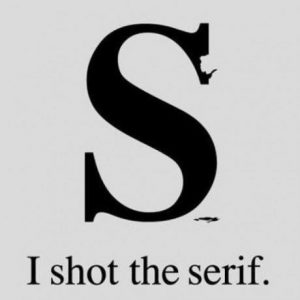
You must be logged in to post a comment.